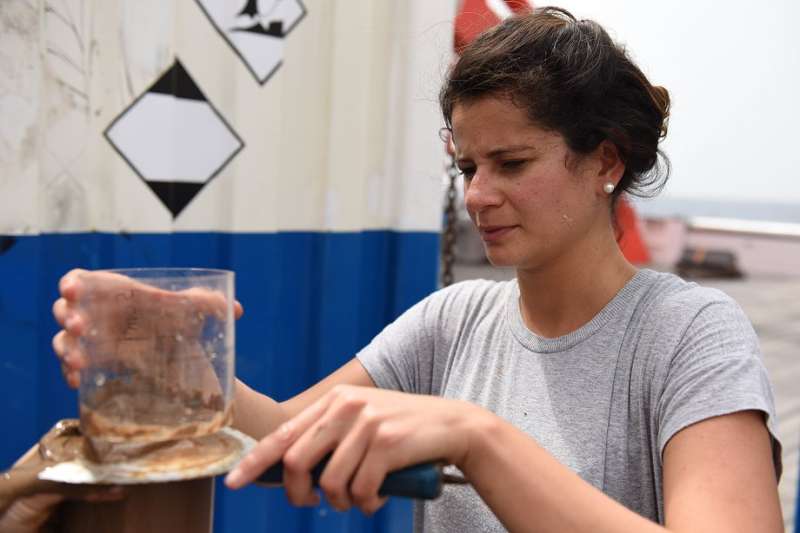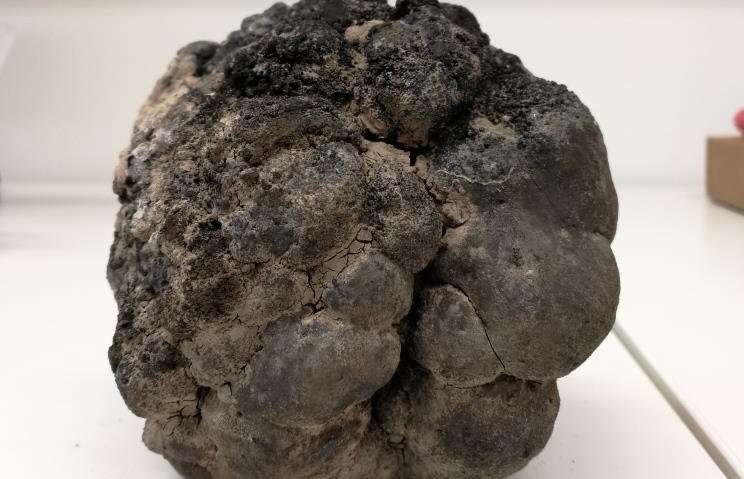Senckenberg scientist Lidia Lins conducts studies on the research vessel. Credit: Ivan Voltski
In cooperation with an international team, Senckenberg scientists examined the impact of deep-sea mining – such as the extraction of manganese nodules – on the species diversity at the ocean floor. They were able to show that even 26 years after the end of the mining activity a significant loss of ground-dwelling organisms can be registered. Filter-feeding animals are particularly affected – more than two decades after the mining operations, almost 80 percent of the species remain absent. The study was recently published in the scientific journal Biogeosciences.
As a matter of course, mining activity leaves traces behind – this is also true for the extraction of raw materials from the ocean floor. "There are reliable studies that show that the extraction of manganese nodules, for example, has a negative impact on life in the deep sea," explains Dr. Lidia Lins of the Senckenberg Research Institute in Frankfurt, and she continues, "However, if and when the animals will recover from the effects of mining has been insufficiently studied to date."
Together with an international team, the junior author of the recently published study therefore examined the effects of the "DISturbance and reCOLonization (DISCOL)" experiment on ground-dwelling deep-sea organisms. During the series of scientific experiments, which started in 1989, 22 percent of an area in the Southeastern Pacific measuring a total of 10.8 square kilometers and rich in manganese nodules was plowed under using heavy equipment. The area was revisited at intervals of one month, six months, three, seven and 26 years after the disturbance to study and assess the diversity of the macro- and megafauna and the occurrence of fish species.
Manganese nodule from the study area in the Pacific. Credit: Senckenberg/Lins
"We utilized this unique time series from the deep sea to develop nutrient cycles for carbonate-producing and carbonate-feeding organisms. From these we can deduct the effects of plowing on the ocean floor within and outside of the plowed areas," explains Lins.
The results are alarming: Even 26 years after the experiment, the total mass of calcifying organisms within the disturbed area was 54 percent lower than the mass outside of the study area. Least affected were organisms that feed on the ocean floor – they only showed a loss of 2.6 percent.
"However, the filter- and suspension-feeding fauna was affected significantly. Here, we observed 80 percent less activity," adds Lins, and she continues, "We were able to show that the ecosystems in the deep sea are recover very slowly from the impact – almost 30 years after a comparatively small disturbance just about half of all life forms have returned to the area. We therefore strongly support the establishment of protection zones in the oceans."
More information: Tanja Stratmann et al. Abyssal plain faunal carbon flows remain depressed 26 years after a simulated deep-sea mining disturbance, Biogeosciences (2018). DOI: 10.5194/bg-15-4131-2018
Journal information: Biogeosciences

























